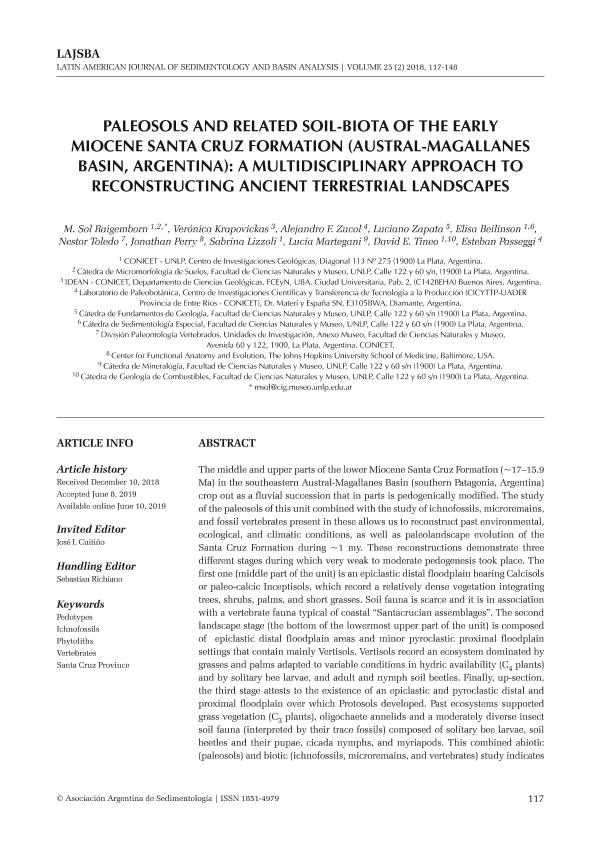Mostrar el registro sencillo del ítem
dc.contributor.author
Raigemborn, María Sol

dc.contributor.author
Krapovickas, Verónica

dc.contributor.author
Zucol, Alejandro Fabián

dc.contributor.author
Zapata, Luciano

dc.contributor.author
Beilinson, Elisa

dc.contributor.author
Toledo, Néstor

dc.contributor.author
Perry, Jonathan
dc.contributor.author
Lizzoli, Sabrina

dc.contributor.author
Martegani, Lucía
dc.contributor.author
Tineo, David

dc.contributor.author
Passeggi, Esteban

dc.date.available
2019-07-23T22:33:41Z
dc.date.issued
2018-07
dc.identifier.citation
Raigemborn, María Sol; Krapovickas, Verónica; Zucol, Alejandro Fabián; Zapata, Luciano; Beilinson, Elisa; et al.; Paleosols and related soil-biota of the early Miocene Santa Cruz Formation (Austral-Magallanes Basin, Argentina): a multidisciplinary approach to reconstructing ancient terrestrial landscapes; Asociación Argentina de Sedimentología; Latin American Journal of Sedimentology and Basin Analysis; 25; 2; 7-2018; 117-148
dc.identifier.issn
1669-7316
dc.identifier.uri
http://hdl.handle.net/11336/80116
dc.description.abstract
The middle and upper parts of the lower Miocene Santa Cruz Formation (~17–15.9 Ma) in the southeastern Austral-Magallanes Basin (southern Patagonia, Argentina) crop out as a fluvial succession that in parts is pedogenically modified. The study of the paleosols of this unit combined with the study of ichnofossils, microremains, and fossil vertebrates present in these allows us to reconstruct past environmental, ecological, and climatic conditions, as well as paleolandscape evolution of the Santa Cruz Formation during ~1 my. These reconstructions demonstrate three different stages during which very weak to moderate pedogenesis took place. The first one (middle part of the unit) is an epiclastic distal floodplain bearing Calcisols or paleo-calcic Inceptisols, which record a relatively dense vegetation integrating trees, shrubs, palms, and short grasses. Soil fauna is scarce and it is in association with a vertebrate fauna typical of coastal “Santacrucian assemblages”. The second landscape stage (the bottom of the lowermost upper part of the unit) is composed of epiclastic distal floodplain areas and minor pyroclastic proximal floodplain settings that contain mainly Vertisols. Vertisols record an ecosystem dominated by grasses and palms adapted to variable conditions in hydric availability (C4 plants) and by solitary bee larvae, and adult and nymph soil beetles. Finally, up-section, the third stage attests to the existence of an epiclastic and pyroclastic distal and proximal floodplain over which Protosols developed. Past ecosystems supported grass vegetation (C3 plants), oligochaete annelids and a moderately diverse insect soil fauna (interpreted by their trace fossils) composed of solitary bee larvae, soil beetles and their pupae, cicada nymphs, and myriapods. This combined abiotic (paleosols) and biotic (ichnofossils, microremains, and vertebrates) study indicates that several factors controlled the landscape evolution during the early Miocene of southeastern Patagonia. Highly aggrading fluvial conditions, variations in the position in the floodplain and in sedimentation/pedogenesis ratio, the input of pyroclastic materials, the length of landscape stability, changing hydrologic conditions, and fluctuations of wetter and drier phases in a context of relatively warm and humid climate, seem to be the main factors controlling the landscape
dc.format
application/pdf
dc.language.iso
eng
dc.publisher
Asociación Argentina de Sedimentología
dc.rights
info:eu-repo/semantics/openAccess
dc.rights.uri
https://creativecommons.org/licenses/by-nc/2.5/ar/
dc.subject
Pedotypes
dc.subject
Ichnofossils
dc.subject
Phytoliths
dc.subject
Vertebrates
dc.subject
Santa Cruz Province
dc.subject.classification
Paleontología

dc.subject.classification
Ciencias de la Tierra y relacionadas con el Medio Ambiente

dc.subject.classification
CIENCIAS NATURALES Y EXACTAS

dc.title
Paleosols and related soil-biota of the early Miocene Santa Cruz Formation (Austral-Magallanes Basin, Argentina): a multidisciplinary approach to reconstructing ancient terrestrial landscapes
dc.type
info:eu-repo/semantics/article
dc.type
info:ar-repo/semantics/artículo
dc.type
info:eu-repo/semantics/publishedVersion
dc.date.updated
2019-07-23T13:00:18Z
dc.journal.volume
25
dc.journal.number
2
dc.journal.pagination
117-148
dc.journal.pais
Argentina

dc.journal.ciudad
La Plata
dc.description.fil
Fil: Raigemborn, María Sol. Consejo Nacional de Investigaciones Científicas y Técnicas. Centro Científico Tecnológico Conicet - La Plata. Centro de Investigaciones Geológicas. Universidad Nacional de La Plata. Facultad de Ciencias Naturales y Museo. Centro de Investigaciones Geológicas; Argentina
dc.description.fil
Fil: Krapovickas, Verónica. Consejo Nacional de Investigaciones Científicas y Técnicas. Oficina de Coordinación Administrativa Ciudad Universitaria. Instituto de Estudios Andinos "Don Pablo Groeber". Universidad de Buenos Aires. Facultad de Ciencias Exactas y Naturales. Instituto de Estudios Andinos "Don Pablo Groeber"; Argentina
dc.description.fil
Fil: Zucol, Alejandro Fabián. Provincia de Entre Ríos. Centro de Investigaciones Científicas y Transferencia de Tecnología a la Producción. Universidad Autónoma de Entre Ríos. Centro de Investigaciones Científicas y Transferencia de Tecnología a la Producción. Consejo Nacional de Investigaciones Científicas y Técnicas. Centro Científico Tecnológico Conicet - Santa Fe. Centro de Investigaciones Científicas y Transferencia de Tecnología a la Producción; Argentina
dc.description.fil
Fil: Zapata, Luciano. Consejo Nacional de Investigaciones Científicas y Técnicas; Argentina. Universidad Nacional de La Plata. Facultad de Ciencias Naturales y Museo; Argentina
dc.description.fil
Fil: Beilinson, Elisa. Consejo Nacional de Investigaciones Científicas y Técnicas. Centro Científico Tecnológico Conicet - La Plata. Centro de Investigaciones Geológicas. Universidad Nacional de La Plata. Facultad de Ciencias Naturales y Museo. Centro de Investigaciones Geológicas; Argentina
dc.description.fil
Fil: Toledo, Néstor. Consejo Nacional de Investigaciones Científicas y Técnicas; Argentina. Universidad Nacional de La Plata. Facultad de Ciencias Naturales y Museo. División Paleontología Vertebrados; Argentina
dc.description.fil
Fil: Perry, Jonathan. University Johns Hopkins; Estados Unidos
dc.description.fil
Fil: Lizzoli, Sabrina. Consejo Nacional de Investigaciones Científicas y Técnicas. Centro Científico Tecnológico Conicet - La Plata. Centro de Investigaciones Geológicas. Universidad Nacional de La Plata. Facultad de Ciencias Naturales y Museo. Centro de Investigaciones Geológicas; Argentina
dc.description.fil
Fil: Martegani, Lucía. Universidad Nacional de La Plata. Facultad de Ciencias Naturales y Museo; Argentina
dc.description.fil
Fil: Tineo, David. Consejo Nacional de Investigaciones Científicas y Técnicas. Centro Científico Tecnológico Conicet - La Plata. Centro de Investigaciones Geológicas. Universidad Nacional de La Plata. Facultad de Ciencias Naturales y Museo. Centro de Investigaciones Geológicas; Argentina
dc.description.fil
Fil: Passeggi, Esteban. Provincia de Entre Ríos. Centro de Investigaciones Científicas y Transferencia de Tecnología a la Producción. Universidad Autónoma de Entre Ríos. Centro de Investigaciones Científicas y Transferencia de Tecnología a la Producción. Consejo Nacional de Investigaciones Científicas y Técnicas. Centro Científico Tecnológico Conicet - Santa Fe. Centro de Investigaciones Científicas y Transferencia de Tecnología a la Producción; Argentina
dc.journal.title
Latin American Journal of Sedimentology and Basin Analysis
dc.relation.alternativeid
info:eu-repo/semantics/altIdentifier/url/http://ppct.caicyt.gov.ar/index.php/lajsba/article/view/14467
Archivos asociados
